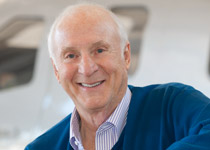GENERAL
- Name at least one type of well-known general aviation airplane in which nosewheel steering is accomplished by depressing a toggle switch in the desired direction (as compared to moving rudder pedals or applying differential braking).
- From reader Tom Renfro: How is it possible to legally use for navigation in IFR flight a VOR receiver that has been checked and found to be in error by as much as 180 degrees?
- The Short Wing Piper Club is a national organization whose members own or have an interest in short-wing Piper aircraft. Can you name those aircraft models considered to be short-wing Pipers?
- From reader Pete Mason: A radial engine (or each row of a radial engine with two or more rows) always has an odd number of cylinders. Why must this always be so?
- What was the world's first aviation regulation?
- Why was the Vought F4U Corsair designed with inverted-gull wings?
- What famous pilot was seriously injured when struck by a propeller and later went on to break a number of significant world aviation records?
MULTIPLE CHOICE
- During World War II and for several years thereafter, general aviation pilots were required during flight to possess a(n)
- airman identification card.
- birth certificate.
- driver's license.
- passport.
- none of the above.
- Aviation area forecasts (FAs) are issued every _____ hours and generally include a forecast period of _____ hours.
- 6, 18
- 8, 18
- 6, 24
- 8, 24
- The world record for the largest animal ever transported by air involved
- an elephant.
- a hippopotamus.
- a killer whale.
- a rhinoceros.
TRUE OR FALSE
- During World War II and for some years thereafter, an applicant for a U.S. pilot certificate had to have been a "U.S. citizen of unquestionable loyalty."
- Everything else being equal, a breeze typically blows up mountain valleys during the day and reverses direction at night.
- A pilot is flying an aircraft with an engine that has been modified with a turbocharger. As the aircraft gains altitude with a constant rpm and manifold pressure, engine horsepower remains constant (until reaching the turbocharger's critical altitude).
- The registration prefix of an aircraft indicates the country in which that aircraft is registered. N is for the United States, C for Canada, 4X for Israel, JY for Jordan, etc. The suffix for a U.S.-registered aircraft always contains at least one number, but the registration suffix everywhere else consists solely of letters, such as 4X-AYH, C-DVD, etc.
ANSWERS
- Such an electro-hydraulic steering control was employed by famed designer Ted Smith in his Aerostar. His Aero Commander twins had similarly unusual nosewheel steering systems.
- According to FAR 91.171(c), a pilot may compare two VOR receivers in the aircraft and use them for IFR flight if they agree within 4 degrees. If one is in error by 176 degrees and the other by 180 degrees, they may legally be used even though common sense dictates otherwise.
- The short-wing Pipers consist of the PA-15/17 Vagabond, PA-16 Clipper, PA-20 Pacer, and PA-22 Tri-Pacer/Colt.
- The firing order of a radial engine follows the motion of the crank-throw during its rotation. This means that when a cylinder fires, the next (adjacent cylinder) is skipped, the next fires, the next is skipped, and so forth. If there were an even number of cylinders, half of them would never fire at all.
- The French instituted a regulation that prohibited the Montgolfier brothers from flying a hot air balloon on Sundays.
- The Corsair had such a huge propeller (13 feet) that the main landing gear would have to have been very long and heavy to elevate the nose high enough to protect the propeller. The wings were "bent downward" so that shorter, lighter wing-mounted main-gear legs could be used.
- Max Conrad, who was known as the "flying grandfather," in 1959 flew nonstop from Casablanca, Morocco, to El Paso, Texas (6,967 sm), in a 180-hp Piper Comanche.
- (a) The blue, wallet-size card was issued by the Civil Aeronautics Administration and contained the pilot's photograph, fingerprint, and signature.
- (b) Six area forecasts cover the 48 states and may be amended more frequently if necessary.
- (c) According to General Aviation News, this occurred in September 1998 when Keiko, the 40,000-pound star of Free Willy, was transported by the United States Air Force in a modified McDonnell Douglas C-17 Globemaster III from Newport, Oregon, to his new home in Iceland.
- True. Pilots also could have been persons "in sympathy with the objectives of the United States and who are trustworthy citizens of a friendly foreign government not under the domination of or associated with any government with which the U.S. is at war."
- True. Such valley and mountain breezes are similar to land and sea breezes that are caused by diurnal heating and cooling.
- False. As altitude increases, the turbocharger compresses increasingly more ambient air to maintain a constant manifold pressure. This increasing compression increases induction-air temperature, which reduces power output somewhat. It is like operating an engine with carburetor heat on.
- False. Although the vast majority of countries utilize only letters in their registration suffix, at least one other country, Russia, uses numbers (as in RA-42423).
Visit the author's Web site ( www.barryschiff.com).

Barry Schiff
Barry Schiff has been an aviation media consultant and technical advisor for motion pictures for more than 40 years. He is chairman of the AOPA Foundation Legacy Society.


